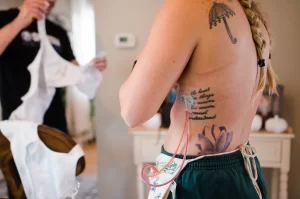Breast Reconstruction Options
The conversation around breast reconstruction surgeries focuses on women who have had either a mastectomy or a lumpectomy done and wish to reconstruct their breasts once they are cancer free. This is a wonderful opportunity for women who are cancer survivors, and of course, a very body-affirming procedure as well! According to 2020 data from the American Society of Plastic Surgeons, breast augmentation surgery has been in the top 5 cosmetic surgeries since 2006, followed by breast implant removals, lifts, and reductions. The highest demographic for breast procedures are women ages 40-54. Sometimes, breast reconstruction surgeries get categorized alongside cosmetic breast procedures. Though there is definitely an overlap, these are the most common breast surgeries:
- Breast augmentation that increases the size of the breasts and may affect the shape and cleavage as well.
- Breast lift, which tightens the existing tissue for a more refined breast shape.
- A combination of breast augmentation with lift, for a one-time makeover.
- Breast revision: patients update their existing implants, can change the size or shape of their breasts, or completely remove the implants.
- Breast reduction for women with excessively large breasts that affect either their body image, create physical problems, or both.
- Male breast reduction for men with excess fat and glandular tissue on their breasts.
All of these procedures reconstruct the breasts in one way or another, and the reasons are often both cosmetic and medical, as well as mental health reasons. A prime example of this is gender affirming top surgery for trans people: either chest feminization or chest masculinization. For chest feminization, surgeons will usually recommend breast augmentation with implants or fat grafting, or a combination. When it comes to chest masculinization, surgeons perform a type of mastectomy that removes breast tissue, eliminates the crease on the bottom of the breast, and reconstructs the nipples according to the patient’s preferences.
Women who have undergone double or partial mastectomy, or a lumpectomy, may choose to have breast reconstruction surgery. Patients whose breast cancer can be removed with surgery have more options on the type of surgery they get done–and can usually have immediate reconstruction surgery right after their breast cancer surgery. However, for medical and/or personal reasons, women can also choose to have delayed reconstruction surgery: months or even years later. There are two main types of post-cancer breast reconstruction surgery:
- Flap Reconstruction: this surgery uses tissue from your own body to form one or both breasts. There are several types of flaps, and the choice is made on a case by case basis. Your surgeon will consider which type is appropriate for you, and whether you safely qualify for this type.
- Implant Reconstruction: much like the cosmetic procedure, silicone or saline implants are used to reconstruct the breast tissue. Your surgeon will either lift the chest muscle and place the implant underneath, or they may place the implant above the chest muscle if they can.
Since every body and case is different, not all options may be available. Whether for medical or cosmetic reasons, consult with your surgeon about your breast surgery options, get several opinions if you can, and see if you are eligible for insurance coverage. Keep in mind some procedures may take a long time to be completed, may need to successfully happen over a period of months, or be regularly maintained to ensure your health and safety.
More


